Aboriginal Cultural ParkGo! (2006, 10/11)
Recorded by: Hsiao-rong
Even though we just had our five-day holidays and expected an exam for tomorrow, we still followed teacher’s plan to write our homework at library after school and took a nap. Teacher appeared at exactly 13:30 and told us what we would complete this afternoon. We and other schoolmates of the second group, fourteen in total, rode separately in three cars of Director Tsai, Teacher Chuo and Teacher Hsu and set off.
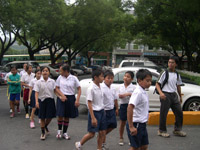
The first stop was the Aboriginal Cultural Park. Since it’s in Majia Township and Teacher Cho was very familiar with them, we went in just by waving our hands. Teachers led us to the bookstore in the park. We saw lots of books about aboriginal people, including history study, customs, sacrificial ceremonies, etc. Probably because there weren’t too many clients around and we were pretty cute, well, actually because teacher knew the keeper, we started to find information straightforwardly. We were so lucky to get free data here; otherwise, we couldn’t afford to buy those books. I got a glimpse of the price tags. Many of them cost one to two thousand dollars. When the sun fell, we returned home with a whole pile of information. We would have to keep the second stop – the Vusam Library for next time.
Vusam Library, here we come! (2006, 10/14)
Recorded by: Rou-rou
In our township, there is only one township library in addition to two elementary school libraries and one junior middle school library. In recent years, the Educational and Cultural Association of Aboriginals also moved into the library. Library collections were increased and more ladies were working in the library. We didn’t come to the library last time because we stayed too long in the Cultural Park. We had two reading classes this afternoon, so teacher drove us here to collect some data.
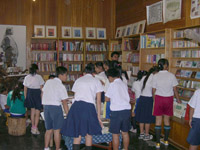 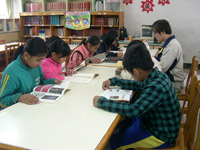
It was always a pleasure to ride in a car and had some fun outside. We brought our notebooks and chatted happily with schoolmates, and here we were at the Vusam Library. (Vusam is Paiwan language, meaning seed). We received a warm welcome from ladies in the library. Since there is a distance to come here from our tribe, we seldom visit here. Some schoolmates came here for the first time. There was a computer room attracting us in the library, but teacher said we didn’t have much time. We had to find data first. Luckily, we had seen most of the books about aboriginals last time and there were only two new books we needed to review. We followed teacher’s instruction to set up in groups and took down necessary parts. We also listened to Teacher Cho’s explanation about aboriginal clothes. We said goodbye to the ladies and returned to school for the next class. I was so glad to spend a meaningful afternoon and knew more about the aboriginals.
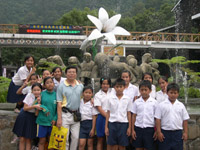
Understood the old and new locations of the Paiwan Village (2006, 10/19)
Recorded by: Hsiao-rong
Teacher led us to have a walk around the Paiwan Village yesterday afternoon. At the sixth class of today, teacher gathered us in the library to explain to us the location of the Paiwan Village. From the map of Pingtung County and Majia Township, teacher let us understand the related locations of each tribe. We were also told that some tribes had different names from before. Some tribes existed before such as the Paiwan Village and Jiayi Village. Some tribes were set up by people moving to other tribes during the Japanese Occupation Period such as the Liangshan Village. My father is from the Liangshan Village and my mother is from the Jiayi Village. I was wondering whether they knew about the tribal history. I must memorize it well so I can tell people afterwards, “ Where I come from?” Where my home is located? There is clear river, green forest and fresh air. Sounds like a nice place worthy of a tour.
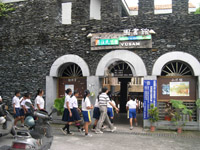 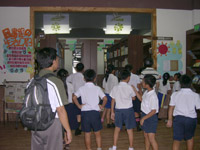
Nose flute data summaries (2006, 12/04)
Recorded by: Hsiao-ning
We were called to gather at the computer room as soon as the noon recess bell sounded. We brought our notebooks and sat down to listen to teacher’s explanation about nose flute. Nose flute is one of the artistic and cultural legacies that Paiwan Tribe feels the most proud of because of its special blowing method, the status of the blower and its sound quality. Before the Japanese Occupation Period, only nobles can blow nose flute. After the Occupation Period, it is gradually opened to civilians. But, there is still a limitation regarding the beautification of nose flute. Chief’s nose flute can add some pattern carvings while civilian’s must be kept in plain. For Paiwan people, the strong sense of belonging it implies has increased its immeasurable value.
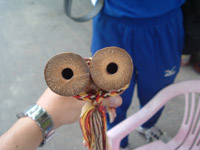 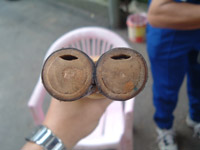
The sounds from a nose flute are quite similar to that of a Hundred-pace Snake. Sometimes it is low and soft, and sometimes it is high but not sharp. Sad and beautiful flute music sounds like telling a story of long long time ago with more sadness than joy. Its main function is to express love between man and woman and the thoughts for kin.
Blow Pipe Bamboo is the material to make nose flute. It belongs to the grass family with thin long stem and knot about 2~4cm in diameter and 30~60cm in length. It grows in clumps. In the old days, people preferred to plant it around the house, farm or orchard as a fence to protect the house or defend the wind. Since it can be used to blow air to help make fire in the kitchen, it is also called Fire Pipe Bamboo. Double-pipe nose flute: One of the pipes does not have finger holes. It is for blowing low-pitched sounds constantly. Another pipe is for blowing the main rhythm with either three holes or five holes. Since two pipes are blown at the same time, the complex tone effect will happen. Even now Paiwan Tribe is still using the nose flute. Its structure is similar to Paiwan’s double-pipe mouth flute. The only difference lies in the blowing hole and size. Nose flute does not have any sound producing structure except round holes. Its pipe is thicker with lower sounds. Because last time Grandpa Jin spoke in mother tongue, we could only catch a few words. Today after teacher’s explanation, we really got to know the “nose flute”.

Top |
